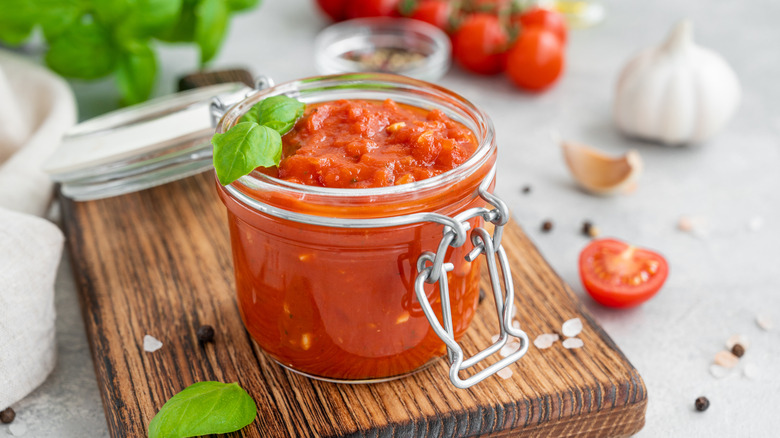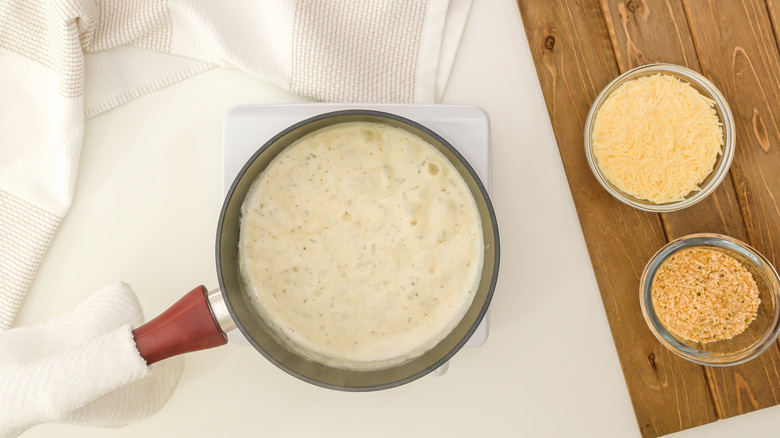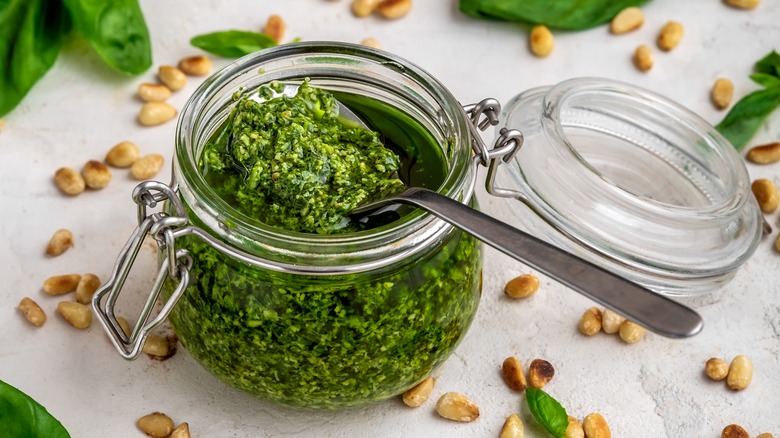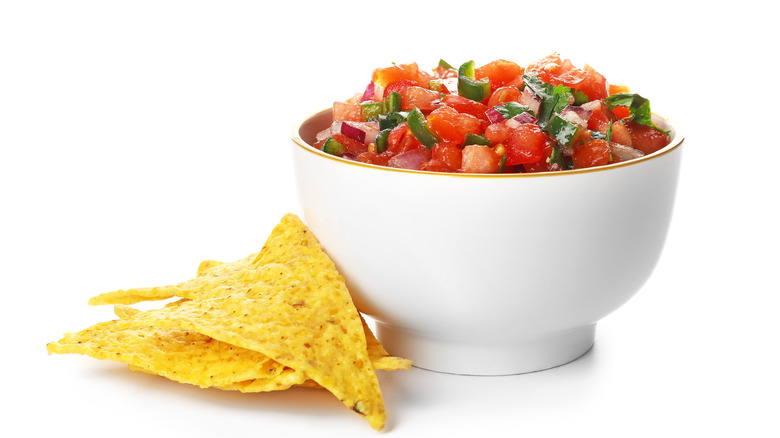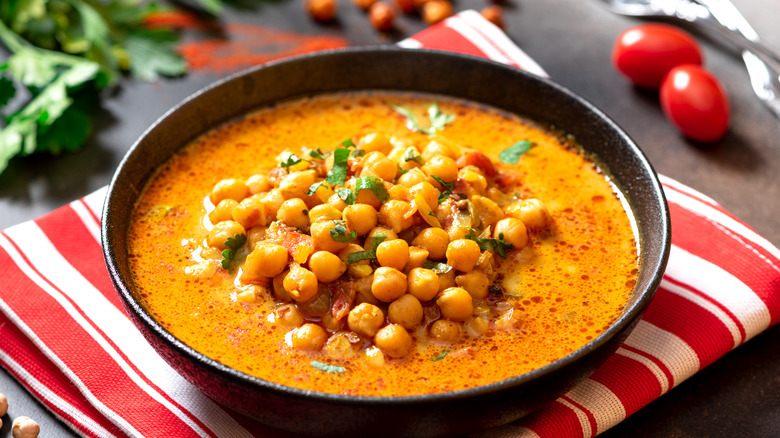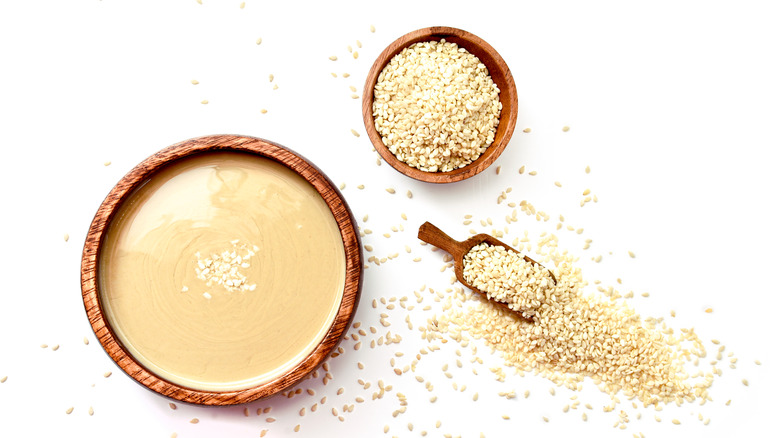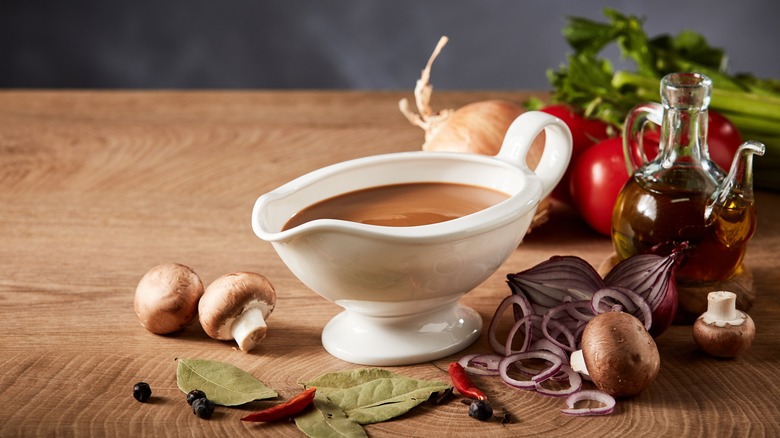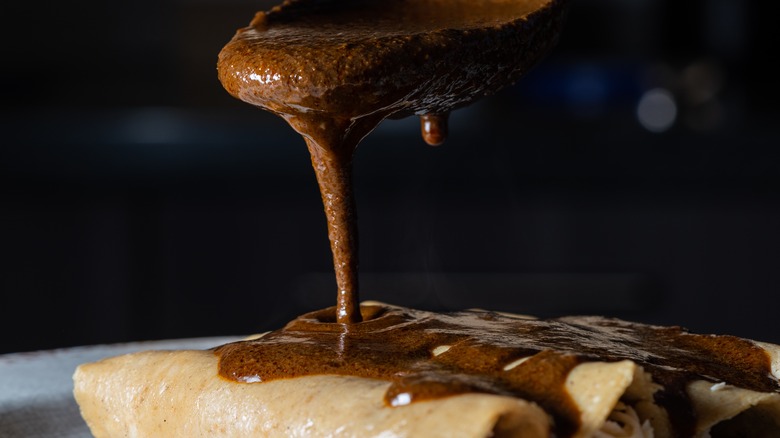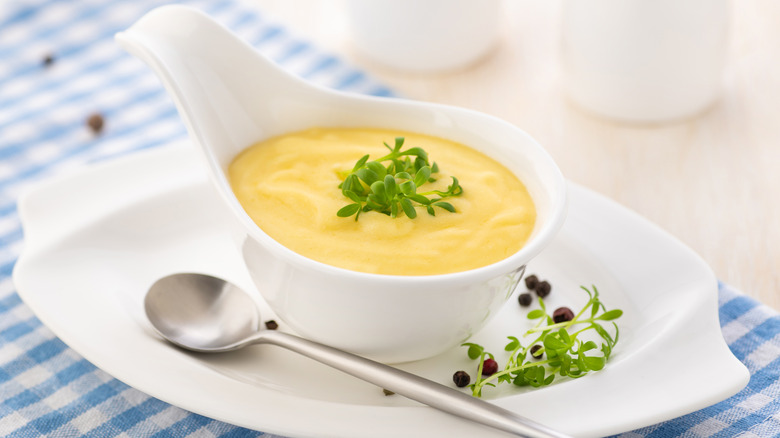9 Canned Sauces You Should Always Have On Hand
We all know that cooking from scratch is better for your wallet — and your waist — than eating out. Dining at a restaurant or getting takeout gets expensive pretty quickly, and restaurant food tends to be heavy on fat and salt. When you cook at home, you have more control over what goes into your meal, as well as how much it costs.
Even for home chefs who love to cook, cooking a full meal from scratch every night can take time, and on some nights, that's time that you just don't have. While you may adore your grandma's recipe for authentic Italian marinara, you may not look forward to spending three or more hours prepping and simmering it.
Canned and jarred sauces are a great way around this predicament. You can still save money (and calories) by cooking at home, without having to make every single component from scratch. Not only that, but canned sauces last for a long time in the pantry, so you can buy them when they are on sale. Keeping your pantry stocked with pre-made sauces — along with dry staples like rice and pasta — means you can throw together a home-cooked meal even after the roughest day at work.
Marinara sauce
Marinara sauce is an Italian pasta sauce, based on tomatoes slow-cooked with garlic and herbs like oregano and basil. Pasta with marinara sauce and a side salad is a perfect meal by itself, but you can use this sauce in a variety of other pasta dishes as well. Layer it with lasagna noodles and ricotta cheese for a vegetarian lasagna, or throw in ground beef and sausage for a meat lover's version. You can also use it in baked ziti, which tastes as good as lasagna but requires a lot less prep time.
Leftover marinara sauce makes a great dipping sauce for breadsticks or mozzarella sticks (frozen is fine — no one will judge you). And what would a meatball grinder be without hot marinara sauce? In a pinch, you can even throw it on homemade pizza.
Marinara sauce is not the only type of canned tomato sauce you should keep on hand. Stock your pantry with arrabbiata sauce, vodka sauce, Bolognese sauce, and others for some variety.
Alfredo sauce
After tomato-based sauces like marinara and Bolognese, alfredo sauce might just be the most popular type of pasta sauce. This creamy sauce uses just a few simple ingredients — butter, cream, Parmesan cheese, parsley, and garlic–to produce a decadent flavor.
Chefs frequently pair alfredo sauce with fettuccine noodles, but it also works well with other long, thin noodles like linguini, tagliatelle, or even spaghetti. But feel free to use whatever type of pasta you have at home — no one is looking! If you want to add some protein, try this Creamy Chicken Alfredo Pasta.
But don't limit yourself to just pasta. Alfredo sauce pairs nicely with baked potatoes, or roasted vegetables like asparagus or broccoli. You can also use it instead of pizza sauce to make a white pizza — buy pre-made pizza dough or a frozen pizza crust to save time. If you are starting with dough, shape it into a crust first. Then spread a generous layer of alfredo sauce on the crust, top it with cheese, and add toppings like broccoli, spinach, mushrooms, canned artichoke hearts, and diced, cooked chicken. The result is a gourmet pizza, and you don't even have to tip the delivery guy.
Pesto sauce
As you work your way through canned and jarred pasta sauces, next up is pesto! Traditionally, pesto sauce is made from a whole lot of basil leaves ground together with pine nuts, olive oil, lemon juice, and Parmesan cheese. It's easy enough to make yourself, especially if you have a food processor and a garden bursting with basil, but it's even easier to buy it at the grocery store. Basil pesto is the most common option, but you may be able to find garlic pesto, red pepper pesto, and even vegan varieties made without cheese.
Pesto works best with short, textured noodles such as gemelli, fusilli, and ziti, because the pesto can cling to the twists and grooves. But you can throw pesto on any kind of noodle and the pasta police will probably leave you alone. You can serve it on hot pasta, or toss it with cold pasta and roasted vegetables for a different take on pasta salad in the summer. You can also try pesto as a spread on sandwiches, or tossed with roasted potatoes.
Pesto packs a punch, so you don't need a lot, even for a large pot of pasta: There is a reason it comes in such a small jar. Start with just a few tablespoons and add more to taste.
Salsa
Salsa literally means sauce in Spanish (via Merriam-Webster), and it's one sauce you should always keep around. Obviously, salsa goes perfectly with tortilla chips, but there's so much more to salsa. And don't limit yourself to salsa roja (red salsa): Branch out to salsa verde (green salsa), mango salsa, black bean, and corn ... the options are only as limited as the stock at your grocery store.
Salsa roja is the most popular salsa, and for good reason: it's delicious. You can find this tomato-and-chile pepper sauce anywhere in mild, medium, and hot, so grab your favorite along with a bag of chips. But don't stop there. Pick up canned refried beans, a bag of shredded cheese, and sour cream, and you are ready to make nachos. Top with canned jalapeno peppers if you can handle it. Add some rotisserie chicken and you've got yourself a meal.
Salsa is a great topping for tacos or burritos, and you can also add it to burrito filling for added flavor. Simply toss a few tablespoons of salsa per burrito into canned beans or shredded chicken, beef, or pork, then roll into a large flour tortilla and heat through. It is the perfect pantry meal. Another easy weeknight dinner is Slow Cooker Salsa Verde Chicken. This recipe uses green salsa to add flavor to chicken breasts. Pop the ingredients in the slow cooker in the morning, and dinner will be done (and your house will smell delicious) by the time you get home from work.
Curry sauce
Once upon a time, if you were an American who wanted Indian food for dinner, you had to live in a city. But now you can enjoy Indian cuisine not just in the suburbs and small towns, but even in your own kitchen. Many grocery stores now carry pre-made curry sauces that taste just as good as the restaurant versions, and save you the hassle of buying multiple jars of spices and standing over the stove, simmering and stirring.
Tikka masala, often used in the popular dish chicken tikka masala, is a tomato- and cream-based sauce that gets its flavor from curry, as well as garam masala, paprika, coriander, cumin, and chili powder. Making your own involves pan-toasting spices, but you can get the same flavor by opening a jar of pre-made tikka masala sauce. Dice a chicken breast, then cook in oil for a few minutes. Add one jar of sauce, simmer for about 15 minutes, and that's it — done in less time than it would take to pick up your takeout. Serve with naan (from the grocery store, of course) or poured over rice.
You can use the same approach with butter chicken sauce or korma sauce. Butter chicken sauce is a butter and tomato-based curry, and korma is a mild coconut-based curry. Butter chicken sauce is meant for chicken, clearly, but you can use tikka masala, korma, or other pre-made curry sauces with any type of meat, firm tofu, or vegetables.
Tahini
Tahini is a key ingredient in hummus, but this versatile sauce pulls its weight in other recipes as well. Tahini is a Middle Eastern sauce made from ground sesame seeds, made much like you would make peanut butter. Once available only in health food stores or ethnic grocery stores, tahini is now stocked at most major grocery stores. Keep it in your pantry to use in hummus, salad dressings, and more. Once opened, you might want to refrigerate it to extend its shelf life, but it will actually be fine at room temperature for a few months.
To make hummus, simply puree one can of chickpeas with a few tablespoons each of tahini, olive oil, and lemon juice, until it reaches the consistency you prefer. Alter the flavor by adding roasted red bell peppers, fresh garlic, or olives — or even beets. To use tahini in salad dressings, whisk it with cider vinegar or lemon juice and a good, grainy mustard, then toss with a green salad. For a spicier dressing, try this Green Chile Tahini Sauce. The creaminess of the beans and tahini balances out the heat of the chile pepper. Drizzle this on salad, roasted vegetables, or grilled meat.
It might sound strange, but you can use tahini in baked goods. Because it has a high fat content and a neutral flavor, it works as a replacement for butter. Try it in these Sesame Cashew and Tahini Blondies.
Canned gravy
Canned gravy might seem like a sin, but it's not. Homemade gravy is great, but it is also a pain to make: You have to frantically whisk the flour with the fat, and you still might end up straining out lumps. All you have to do with canned gravy is open it, and it is perfectly smooth, every time.
Obviously, gravy is fantastic served over pretty much any type of meat and mashed potatoes, or even baked potatoes. But that's not all you can do with canned gravy. Spread one to two tablespoons onto your turkey and cranberry sauce sandwich after Thanksgiving — though use it sparingly, or you will end up with soggy bread. You can also use it as an ingredient when cooking meat. Pan-cooked chicken, steak, and pork chops all soak up the flavor when you cook them in gravy.
And here is the easiest meal of all: slow-cooker Swedish meatballs. Throw a bag of frozen meatballs into your slow cooker along with a jar of gravy, a can of cream of mushroom soup, and some water, then cook on low all day. Add water if the meatballs start to look dry. They might not be authentically Swedish, but they are definitely delicious.
Enchilada sauce
Canned enchilada sauce makes it easy to throw together Mexico's contribution to the casserole world: enchiladas. Enchiladas are made from either corn or flour tortillas that have been filled with beans, vegetables, potatoes, meat, or cheese, then rolled up, placed in a casserole dish, covered with enchilada sauce, and smothered with cheese. Enchiladas are the perfect weeknight dinner, especially if you use other pantry-friendly components like canned beans and store-bought tortillas.
Red enchilada sauce, which is made from red chiles, is the most common, but you can also find green enchilada sauce (made from green chiles and tomatillos) as well as molé sauce (made from chocolate and surprisingly delicious too). These sauces are not just for enchiladas, though. You can drizzle enchilada sauce on chimichangas, tostadas, and tacos, much like you would use salsa or hot sauce.
You can also use it to flavor ground beef for Tex-Mex pasta, Mexican lasagna, or Mexican stuffed peppers. Add half a can of enchilada sauce to the ground beef while you sauté it to infuse the beef with a little bit of heat — and a lot of flavor.
Hollandaise sauce
If brunch is the highlight of your weekend, then hollandaise sauce is probably already on your list of pantry favorites. This simple sauce is made from nothing more than lemon juice, water, egg yolks, and butter, but it requires standing over a hot stove, constantly whisking the mixture to produce a smooth sauce. Pulling a can off the shelf is a lot faster and produces a brunch that is just as tasty.
To throw together your own eggs Benedict, just top a toasted English muffin with poached eggs, Canadian bacon, and hollandaise sauce. For vegetarians, try eggs Florentine, which swaps out the Canadian bacon for wilted spinach. Drizzle leftover hollandaise sauce on steak or salmon, roasted vegetables like asparagus or broccoli, or on baked potatoes.
You can also use hollandaise sauce in a breakfast casserole. Breakfast casseroles are a great way to use up leftover veggies and cheese that are taking up space in your refrigerator. Choose a carbohydrate base like a loaf of day-old bread, or a package of pre-made hash browns. Sauté an onion, then throw in your vegetables. Mushrooms, bell peppers, and spinach all work well here. If you like, toss in crumbled sausage or cooked bacon. Mix everything together with one jar of hollandaise sauce, then spread in a casserole dish and bake. You can even prep this the night before — just bake it for an extra five to ten minutes to make sure it cooks all the way through before serving.

